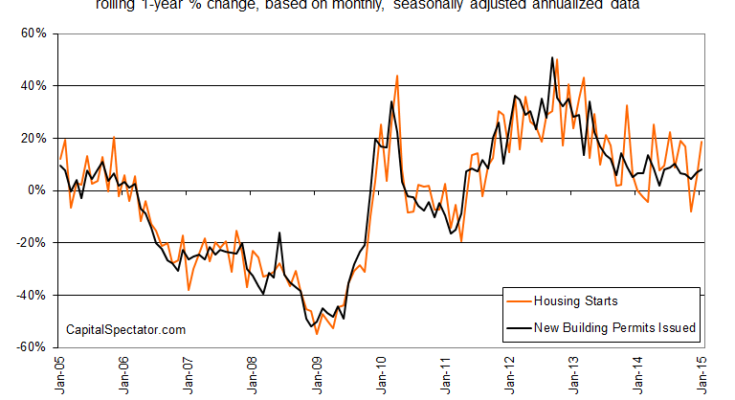Today’s US updates for residential housing construction and industrial production fell short of expectations for the monthly comparisons, but the year-over-year trends are looking brighter. The January release on industrial activity is especially encouraging. It all adds up to a change for the better for anticipating that business cycle risk in the US will remain low for the foreseeable future.
Let’s start with housing. Although no one will confuse the latest data with a booming market, once we look past the monthly noise we see what appears to be a trend that may be stabilizing on the side of modest growth. Indeed, new construction rebounded sharply last month in annual terms, rising nearly 19% in January vs. the year-earlier level. The gain marks the second straight month of year-over-year growth. Meantime, newly issued building permits—a clue for predicting future construction activity—continued advancing at a moderate pace, rising a bit more than 8% through January—the most since last August.

The trend in industrial activity looks even better. Output is higher by 4.8% for the year through last month, which is close to the strongest pace in the last four years. The crucial manufacturing component did quite a bit better in today’s update, posting a solid 5.6% advance in January vs. the year-earlier level. That’s the strongest annual gain since Feb. 2011.

Yes, you can spin the story a few shades darker if you focus on the monthly changes. But the short term figures are almost always misleading in the search for big-picture business cycle trends.
With that in mind, today’s numbers suggest that US macro trend continues to hum along… if we’re looking at the annual rates of change. Housing is still wobbly, at least relative to the stronger gains we’ve seen lately in payrolls. There’s also some concern that retail spending may have hit a speed bump. But measured by the year-over-year trend, residential construction and industrial output are off to an encouraging start in 2015. Given the solid advances in the labor market in recent months, today’s updates leave room for assuming that economic growth will roll on for the near-term future.

